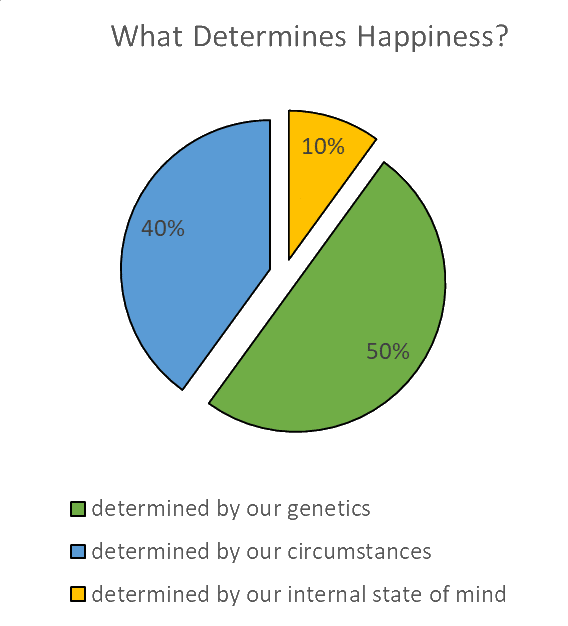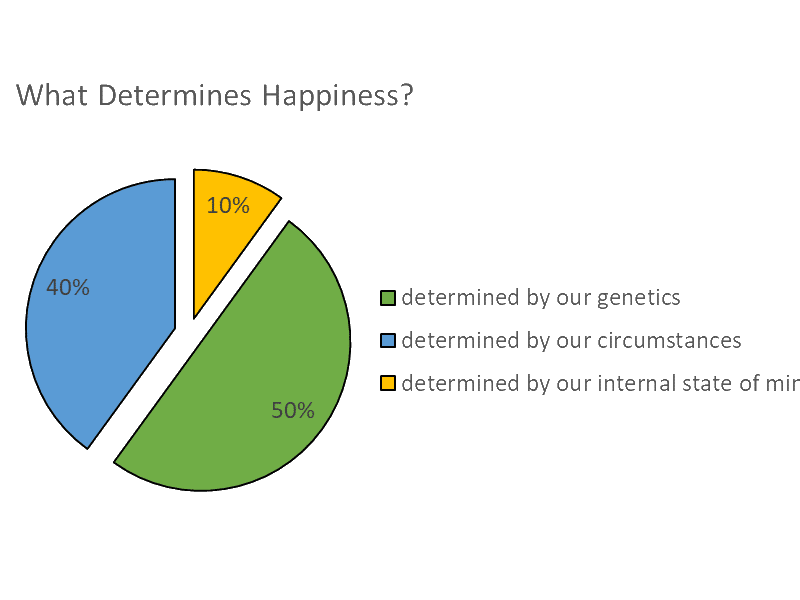One of the most quoted rules of happiness is the 50-40-10 rule. This knowledge about happiness states that 50% of our happiness is determined by genetics, 10% by our circumstances and 40% by our internal state of mind. This rule originates from the book “The How Of Happiness” written by Sonja Lyubomirsky. A lot of people and even psychologists live by this rule.
But what actually determined this so-called rule? Why is 50% of our happiness determined by genetics, and not 48% or 52%? Are these percentages even accurate? The unfortunate answer is that these percentages are not a result of empirical data.
This article aims to shed light on the source of this 50-40-10 rule, what it actually means and what you should think if you ever hear someone quote this rule again.

Contents
What is the 50-40-10 rule of happiness?
The 50-40-10 rule was determined by Sonja Lyubomirksy, a professor of psychology who wrote the book “The How Of Happiness”. This book is primarily about this 50-40-10 rule.
The 50-40-10 rule of happiness is as follows:
- 50% of our happiness is determined by our genetics
- 10% of our happiness is determined by our circumstances
- 40% of our happiness is determined by our internal state of mind
The book includes a pie chart similar to the one visualized below:

The book uses this “rule” to show how important it is to pursue happiness, as it happens that we can always control 40% of our happiness. This is what the author calls the “40 percent solution”. It means that no matter what our circumstances are, we always have the power to influence our happiness by changing our personal outlook.
This is something I strongly agree with. More often than not, happiness is something that we can control and often comes from within.
However, who determined that this part of the “happiness pie” is 40%? Why not 30%? Why not 45%?
This sparked my interest, especially since this 50-40-10 rule is one of the most quoted happiness insights. Surely, this figure must be based on real and empirical data, I thought. I was looking forward to reading about the big and complex surveys that the author conducted in order to find out this interesting happiness fact.
Unfortunately, I was a bit disappointed.
Is the 50-40-10 rule based on real data?
Let’s cut to the chase: the 50-40-10 rule of happiness is not based on actual data. In fact, the essence of this rule is one-hundred percent anecdotal.
I will use pieces of the book (“The How Of Happy”) here to show you how this 50-40-10 rule was actually determined. Here’s the biggest one:
Ken, David, and I were skeptical of the conclusion that lasting happiness was impossible and determined to prove that it was wide off the mark. The result of our discussions over the next few years was a discovery about the causes of well-being. Together we were essentially able to identify the most important factors determining happiness, represented in the following simple pie chart.
What follows is the pie-chart that I showed you above.
What strikes me most, is that Dr. Lyubomirsky and her colleagues were “essentially able to identify the most important factors determining happiness” based on “the result of our discussions“.
When I read this, I was quite unsettled that this anecdotal statement has received so many quotations across the internet, as it’s presented in a way that makes people believe that this 50-40-10 rule is based on actual research.
Dr. Lyubomirsky’s discussions on happiness
In her book, Sonja Lyubomirsky states that her discussions with Ken and David resulted in the 50-40-10 happiness rule. The following text is quoted from the book:
One of those conversations was with fellow professors Ken Sheldon and David Schkade. I had e-mailed them before the trip and asked if we could meet to talk about writing an article that would categorize the different ways that people pursue happiness. Sitting together, however, we rapidly realized that almost no empirical research existed on this subject.
Notice the part where they “rapidly realized that almost no empirical research existed on this subject“. What’s ironic is that the bigger part of the book “The How Of Happiness” is about how you can control the 40% of your happiness, which is actually anecdotal and not based on empirical research.
Studies on the 50-40-10 happiness rule?
In her book “The How Of Happiness”, Dr. Lyubomirsky refers to a paper that she collaborated on with Ken Sheldon and David Schkade called “Pursuing Happiness: The Architecture of Sustainable Change“.
This paper collects and summarizes studies that are used to identify which factors determine happiness. For example, the paper discusses studies on the genetics of happiness. You can read the paper, or alternatively, you can watch this part of an interview below, where Sonja Lyubomirsky discusses this topic:
Now, I’m not arguing that the genetic effect of happiness is untrue. I do believe that some people have a different “default happiness setting” and that some people are more inclined to feel happy.
What bothers me is that somehow, this genetic part of happiness is determined to account for 50% of your happiness. This 50% is not based on empirical research and only “a result of our discussions“.
Empirical data about determining happiness
Here’s one final quote from the book “The How Of Happiness”, that piqued my interest:
Alas, has happiness today become a fad, like hula hoops, big hairdos, and Fonzie? It can certainly appear so, with the market saturated with newspaper and magazine pieces, television documentaries, books, quotes, blogs, and podcasts on the topic, the vast majority of which are relatively uninformed by empirical data. Not infrequently, this frenzy drives researchers like myself to want to keep a distance, yet I think it’s essential to engage in the national discussion about happiness and insist that it abide by strict scientific standards. Why? Because I believe deeply in the importance of the scientific study of happiness and well-being.
While I agree with pretty much everything she said here, I still find it ironic that the 50-40-10 rule is not supported by scientific studies. Sure, I absolutely agree with the theorem that happiness is determined by genetics, circumstances and your personal mindset. However, the lack of any supportive study that determines the actual percentages of these factors baffles me.
This is something that I want to change (more on that later).
Why I agree with Dr. Lyubomirsky
Despite the seemingly harsh criticism that I provide in this article, I agree with a lot of topics with Dr. Lyubomirsky.
For instance, I too believe that:
- A significant chunk of our happiness can be “controlled”
- Some people are more inclined to live a happier life than others
- The topic of happiness needs more empirical research that can be quantified
There are far too many pieces of media floating around the internet today that are simply wrong. The topic of happiness has fallen victim to this as well.
Big media companies notice the demand for solid advice on how to live a happier life, and try to capitalize on that with thin, unsupported and sometimes even sponsored content. In maintaining this website, I see examples of this every single day, and it saddens me. Why? Because it often misinforms people into making wrong decisions in life. I try to counter this by publishing articles that are well-referenced with peer-reviewed studies, while still maintaining a down-to-earth view on the topic. After all, I am also just a faulty human-being trying to be as happy as possible.
Anyway, on the off-chance that Dr. Lyubomirsky might actually be reading this, I want to clarify here that I absolutely support your research, and that I’m a big fan of your work. 🙂
(New!) Happiness survey about the 50-40-10 rule
I don’t want to be “that guy” that only complains without trying to improve his situation.
So I ran a survey and asked the respondents about these topics.
Here are the results:
- 40% of your happiness is determined by your internal state of mind.
- 36% of your happiness is circumstantial.
- 24% of your happiness is genetic.
Closing words
There you have it. By now, you should know what the 50-40-10 rule of happiness is, and how you can use this knowledge in your life. I also hope you know that the percentages are definitely not set in stone. At least, not until these percentages are actually determined by empirical data.
What do you think? Do you disagree with this article? Do you live by the 50-40-10 rule and want to tell me that I’m wrong? Or maybe you want to share your own version of the rule? I’d love to hear all about it in the comments below!


Thanks so much for this
Two men looked through prison bars:
One saw mud
The other stars
It all depends on your perspective and how you want to view things. I choose happiness & positivity. You really CAN see something good in everything IF you look hard enough.
100%! 🙂
Great article on happiness.. I got answer of many questions regarding happiness